technical specifications FIAT STRADA 2015 Owner handbook (in English)
[x] Cancel search | Manufacturer: FIAT, Model Year: 2015, Model line: STRADA, Model: FIAT STRADA 2015Pages: 187, PDF Size: 8.06 MB
Page 7 of 187
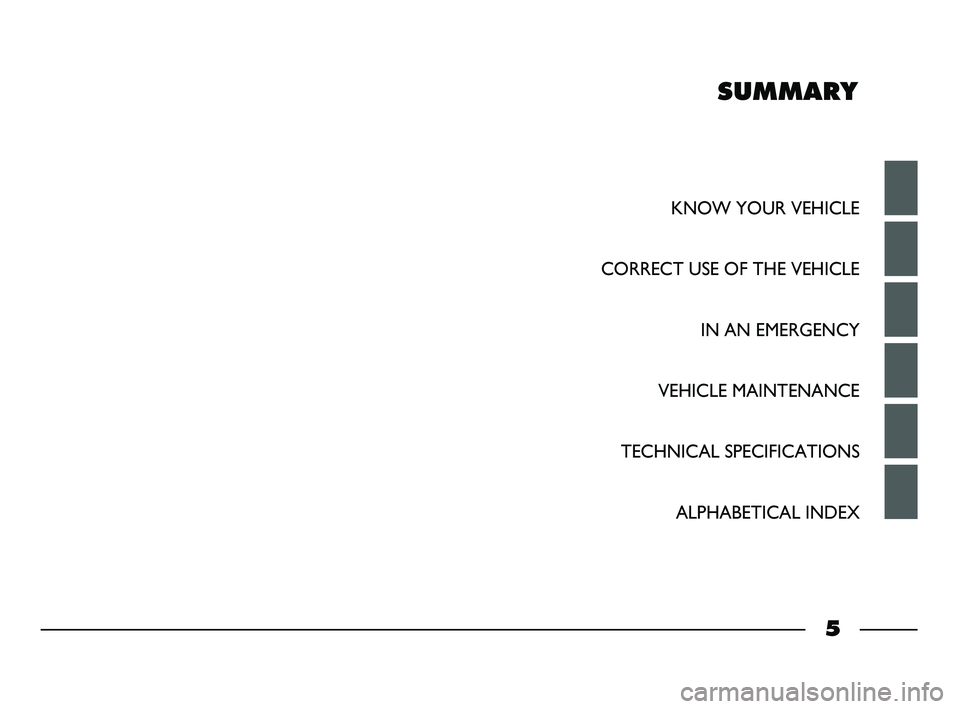
SUMMARY
KNOW YOUR VEHICLE
CORRECT USE OF THE VEHICLE
IN AN EMERGENCY
VEHICLE MAINTENANCE
TECHNICAL SPECIFICATIONS
ALPHABETICAL INDEX
5
001-006 STRADA LUM GB 1ed 9-01-2012 14:48 Pagina 5
Page 101 of 187
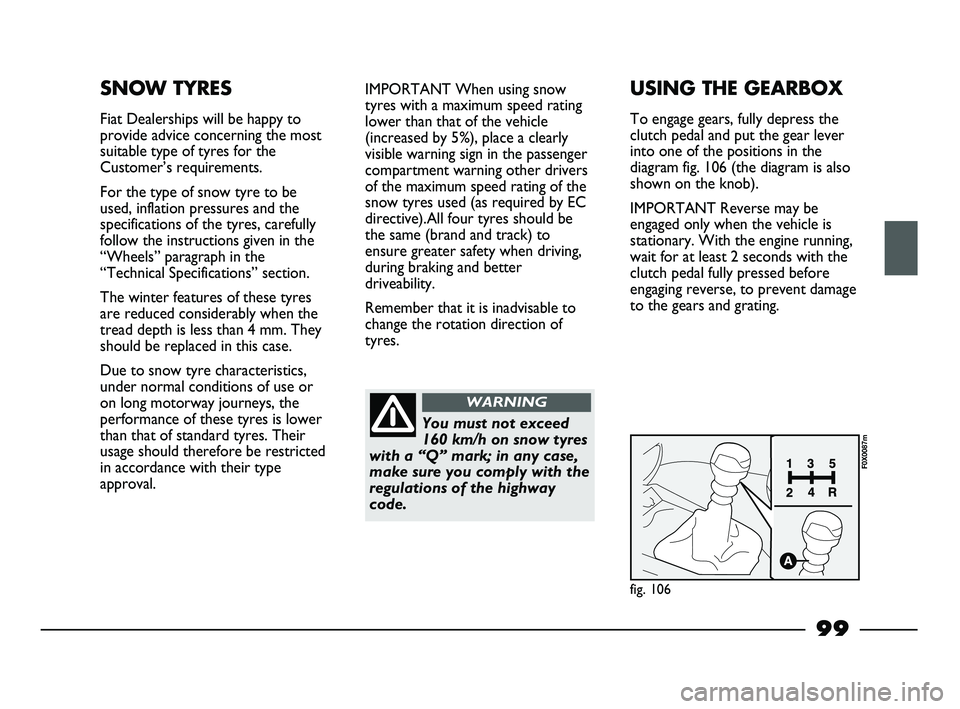
99
SNOW TYRES
Fiat Dealerships will be happy to
provide advice concerning the most
suitable type of tyres for the
Customer’s requirements.
For the type of snow tyre to be
used, inflation pressures and the
specifications of the tyres, carefully
follow the instructions given in the
“Wheels” paragraph in the
“Technical Specifications” section.
The winter features of these tyres
are reduced considerably when the
tread depth is less than 4 mm. They
should be replaced in this case.
Due to snow tyre characteristics,
under normal conditions of use or
on long motorway journeys, the
performance of these tyres is lower
than that of standard tyres. Their
usage should therefore be restricted
in accordance with their type
approval.IMPORTANT When using snow
tyres with a maximum speed rating
lower than that of the vehicle
(increased by 5%), place a clearly
visible warning sign in the passenger
compartment warning other drivers
of the maximum speed rating of the
snow tyres used (as required by EC
directive).All four tyres should be
the same (brand and track) to
ensure greater safety when driving,
during braking and better
driveability.
Remember that it is inadvisable to
change the rotation direction of
tyres.
USING THE GEARBOX
To engage gears, fully depress the
clutch pedal and put the gear lever
into one of the positions in the
diagram fig. 106 (the diagram is also
shown on the knob).
IMPORTANT Reverse may be
engaged only when the vehicle is
stationary. With the engine running,
wait for at least 2 seconds with the
clutch pedal fully pressed before
engaging reverse, to prevent damage
to the gears and grating.
You must not exceed
160 km/h on snow tyres
with a “Q” mark; in any case,
make sure you comply with the
regulations of the highway
code.
WARNING
fig. 106
F0X0087m
095-106 STRADA LUM GB 1ed 9-01-2012 14:51 Pagina 99
Page 102 of 187
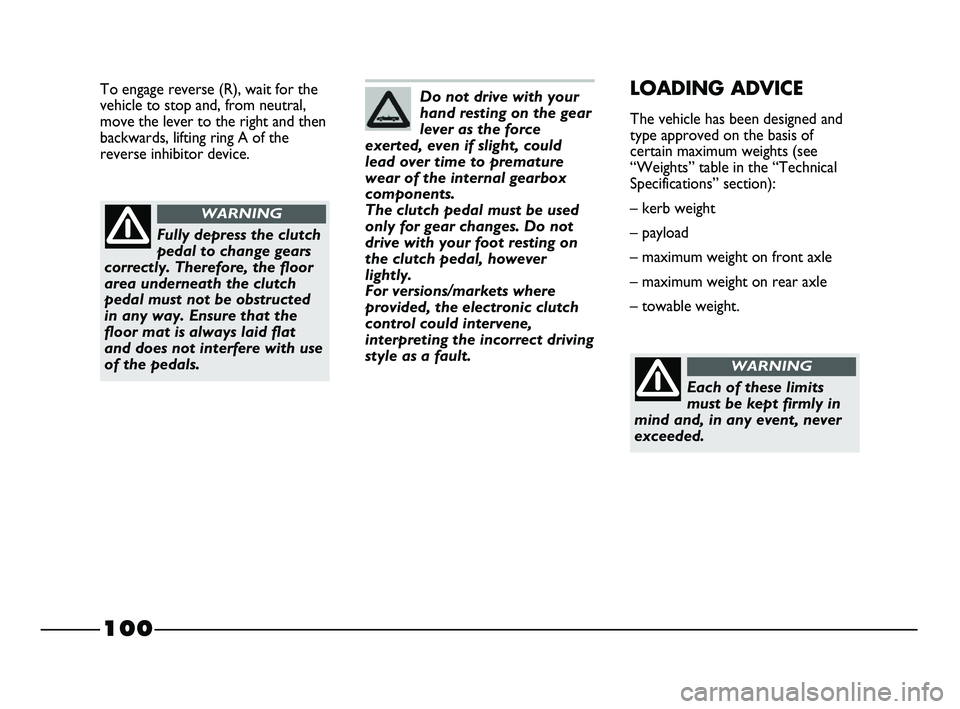
100
To engage reverse (R), wait for the
vehicle to stop and, from neutral,
move the lever to the right and then
backwards, lifting ring A of the
reverse inhibitor device.
Fully depress the clutch
pedal to change gears
correctly. Therefore, the floor
area underneath the clutch
pedal must not be obstructed
in any way. Ensure that the
floor mat is always laid flat
and does not interfere with use
of the pedals.
WARNING
Do not drive with your
hand resting on the gear
lever as the force
exerted, even if slight, could
lead over time to premature
wear of the internal gearbox
components.
The clutch pedal must be used
only for gear changes. Do not
drive with your foot resting on
the clutch pedal, however
lightly.
For versions/markets where
provided, the electronic clutch
control could intervene,
interpreting the incorrect driving
style as a fault.LOADING ADVICE
The vehicle has been designed and
type approved on the basis of
certain maximum weights (see
“Weights” table in the “Technical
Specifications” section):
– kerb weight
– payload
– maximum weight on front axle
– maximum weight on rear axle
– towable weight.
Each of these limits
must be kept firmly in
mind and, in any event, never
exceeded.
WARNING
095-106 STRADA LUM GB 1ed 9-01-2012 14:51 Pagina 100
Page 115 of 187
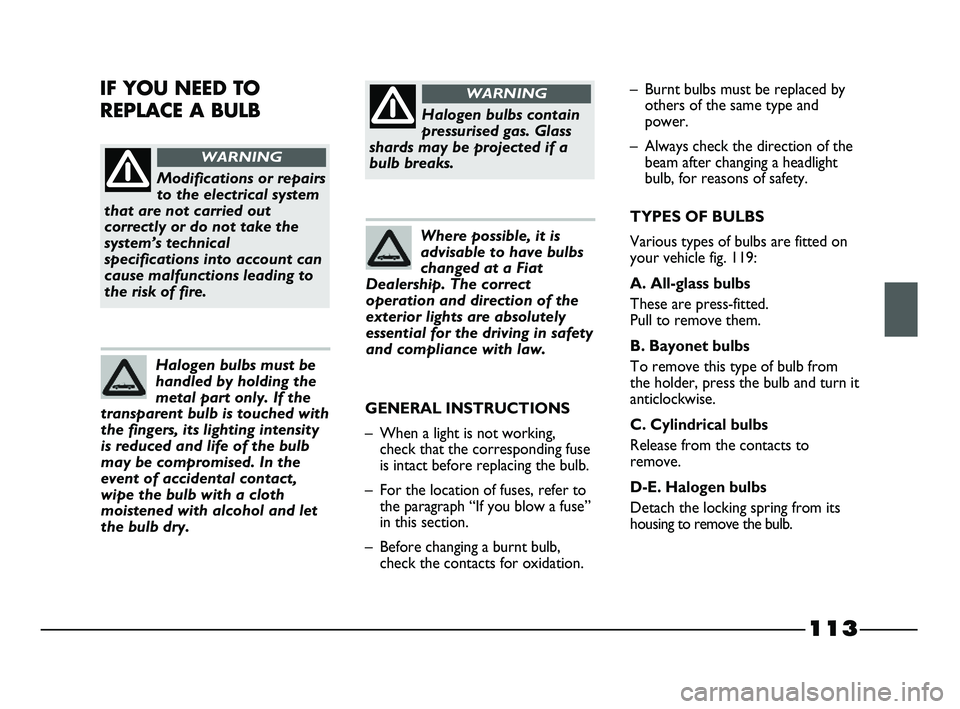
113
Modifications or repairs
to the electrical system
that are not carried out
correctly or do not take the
system’s technical
specifications into account can
cause malfunctions leading to
the risk of fire.
WARNING
Halogen bulbs contain
pressurised gas. Glass
shards may be projected if a
bulb breaks.
WARNING
Halogen bulbs must be
handled by holding the
metal part only. If the
transparent bulb is touched with
the fingers, its lighting intensity
is reduced and life of the bulb
may be compromised. In the
event of accidental contact,
wipe the bulb with a cloth
moistened with alcohol and let
the bulb dry.
Where possible, it is
advisable to have bulbs
changed at a Fiat
Dealership. The correct
operation and direction of the
exterior lights are absolutely
essential for the driving in safety
and compliance with law.
– Burnt bulbs must be replaced by
others of the same type and
power.
– Always check the direction of the
beam after changing a headlight
bulb, for reasons of safety.
TYPES OF BULBS
Various types of bulbs are fitted on
your vehicle fig. 119:
A. All-glass bulbs
These are press-fitted.
Pull to remove them.
B. Bayonet bulbs
To remove this type of bulb from
the holder, press the bulb and turn it
anticlockwise.
C. Cylindrical bulbs
Release from the contacts to
remove.
D-E. Halogen bulbs
Detach the locking spring from its
housing to remove the bulb.IF YOU NEED TO
REPLACE A BULB
GENERAL INSTRUCTIONS
– When a light is not working,
check that the corresponding fuse
is intact before replacing the bulb.
– For the location of fuses, refer to
the paragraph “If you blow a fuse”
in this section.
– Before changing a burnt bulb,
check the contacts for oxidation.
107-132 STRADA LUM GB 1ed 9-01-2012 14:52 Pagina 113
Page 139 of 187
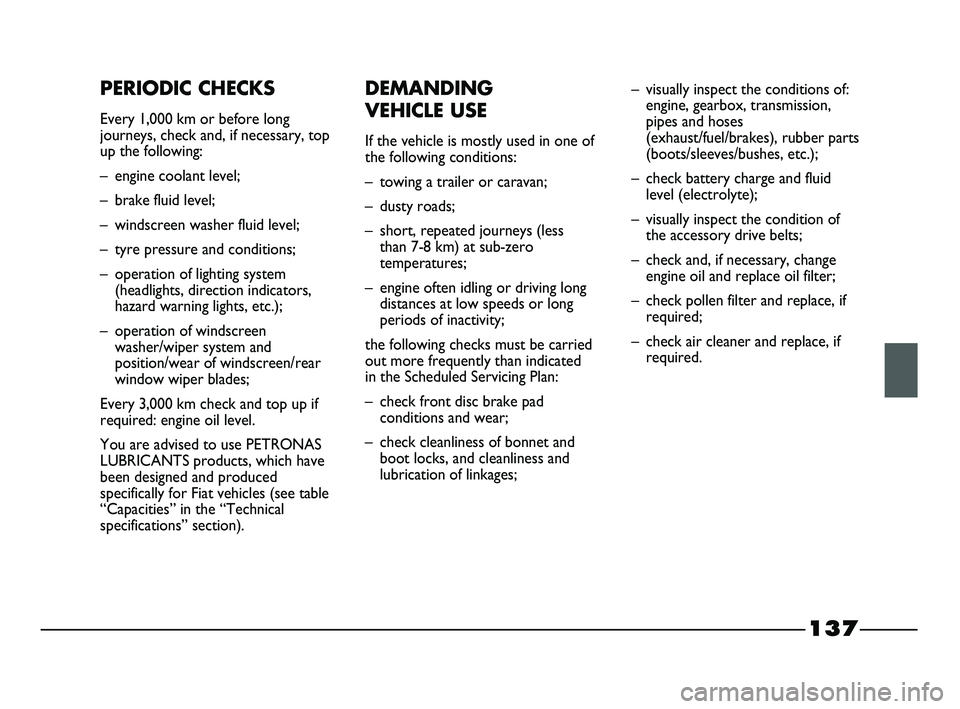
137
PERIODIC CHECKS
Every 1,000 km or before long
journeys, check and, if necessary, top
up the following:
– engine coolant level;
– brake fluid level;
– windscreen washer fluid level;
– tyre pressure and conditions;
– operation of lighting system
(headlights, direction indicators,
hazard warning lights, etc.);
– operation of windscreen
washer/wiper system and
position/wear of windscreen/rear
window wiper blades;
Every 3,000 km check and top up if
required: engine oil level.
You are advised to use PETRONAS
LUBRICANTS products, which have
been designed and produced
specifically for Fiat vehicles (see table
“Capacities” in the “Technical
specifications” section).
DEMANDING
VEHICLE USE
If the vehicle is mostly used in one of
the following conditions:
– towing a trailer or caravan;
– dusty roads;
– short, repeated journeys (less
than 7-8 km) at sub-zero
temperatures;
– engine often idling or driving long
distances at low speeds or long
periods of inactivity;
the following checks must be carried
out more frequently than indicated
in the Scheduled Servicing Plan:
– check front disc brake pad
conditions and wear;
– check cleanliness of bonnet and
boot locks, and cleanliness and
lubrication of linkages;– visually inspect the conditions of:
engine, gearbox, transmission,
pipes and hoses
(exhaust/fuel/brakes), rubber parts
(boots/sleeves/bushes, etc.);
– check battery charge and fluid
level (electrolyte);
– visually inspect the condition of
the accessory drive belts;
– check and, if necessary, change
engine oil and replace oil filter;
– check pollen filter and replace, if
required;
– check air cleaner and replace, if
required.
133-154 STRADA LUM GB 1ed 9-01-2012 14:53 Pagina 137
Page 144 of 187
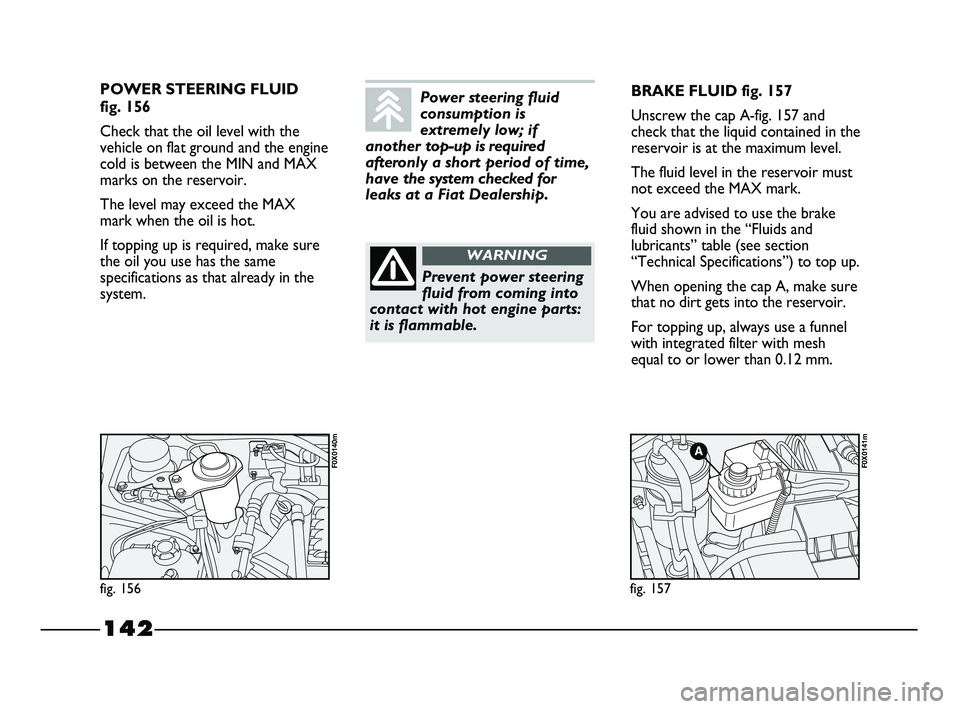
142
POWER STEERING FLUID
fig. 156
Check that the oil level with the
vehicle on flat ground and the engine
cold is between the MIN and MAX
marks on the reservoir.
The level may exceed the MAX
mark when the oil is hot.
If topping up is required, make sure
the oil you use has the same
specifications as that already in the
system.BRAKE FLUID fig. 157
Unscrew the cap A-fig. 157 and
check that the liquid contained in the
reservoir is at the maximum level.
The fluid level in the reservoir must
not exceed the MAX mark.
You are advised to use the brake
fluid shown in the “Fluids and
lubricants” table (see section
“Technical Specifications”) to top up.
When opening the cap A, make sure
that no dirt gets into the reservoir.
For topping up, always use a funnel
with integrated filter with mesh
equal to or lower than 0.12 mm.
fig. 157
F0X0141m
fig. 156
F0X0140m
Power steering fluid
consumption is
extremely low; if
another top-up is required
afteronly a short period of time,
have the system checked for
leaks at a Fiat Dealership.
Prevent power steering
fluid from coming into
contact with hot engine parts:
it is flammable.
WARNING
133-154 STRADA LUM GB 1ed 9-01-2012 14:53 Pagina 142
Page 149 of 187
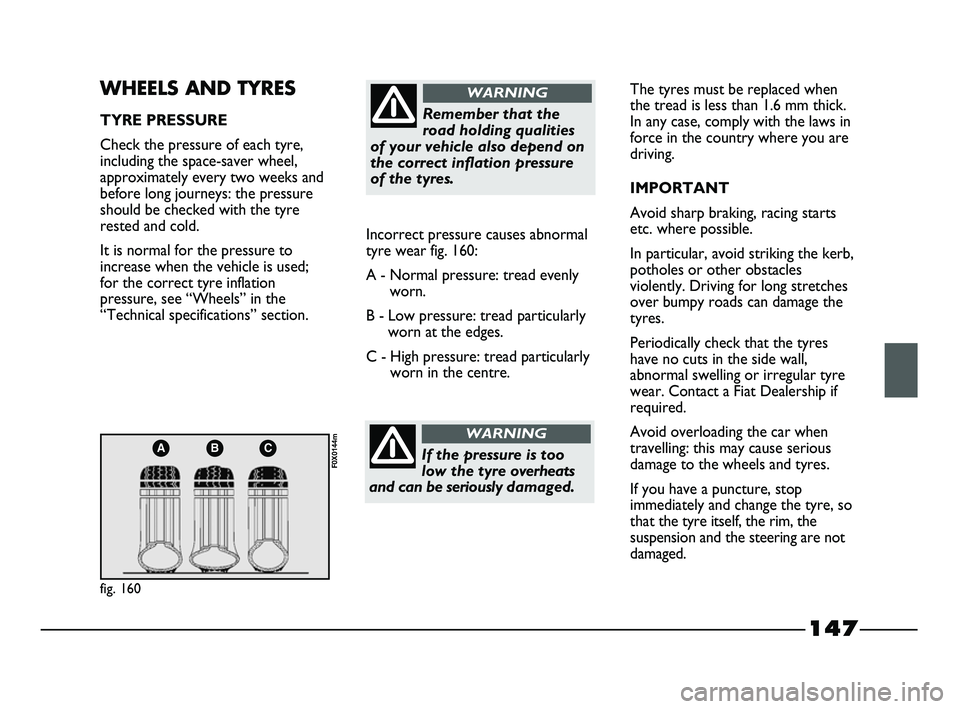
147
ABC
fig. 160
F0X0144m
WHEELS AND TYRES
TYRE PRESSURE
Check the pressure of each tyre,
including the space-saver wheel,
approximately every two weeks and
before long journeys: the pressure
should be checked with the tyre
rested and cold.
It is normal for the pressure to
increase when the vehicle is used;
for the correct tyre inflation
pressure, see “Wheels” in the
“Technical specifications” section.Incorrect pressure causes abnormal
tyre wear fig. 160:
A - Normal pressure: tread evenly
worn.
B - Low pressure: tread particularly
worn at the edges.
C - High pressure: tread particularly
worn in the centre.Remember that the
road holding qualities
of your vehicle also depend on
the correct inflation pressure
of the tyres.
WARNING
If the pressure is too
low the tyre overheats
and can be seriously damaged.
WARNING
The tyres must be replaced when
the tread is less than 1.6 mm thick.
In any case, comply with the laws in
force in the country where you are
driving.
IMPORTANT
Avoid sharp braking, racing starts
etc. where possible.
In particular, avoid striking the kerb,
potholes or other obstacles
violently. Driving for long stretches
over bumpy roads can damage the
tyres.
Periodically check that the tyres
have no cuts in the side wall,
abnormal swelling or irregular tyre
wear. Contact a Fiat Dealership if
required.
Avoid overloading the car when
travelling: this may cause serious
damage to the wheels and tyres.
If you have a puncture, stop
immediately and change the tyre, so
that the tyre itself, the rim, the
suspension and the steering are not
damaged.
133-154 STRADA LUM GB 1ed 9-01-2012 14:53 Pagina 147
Page 153 of 187
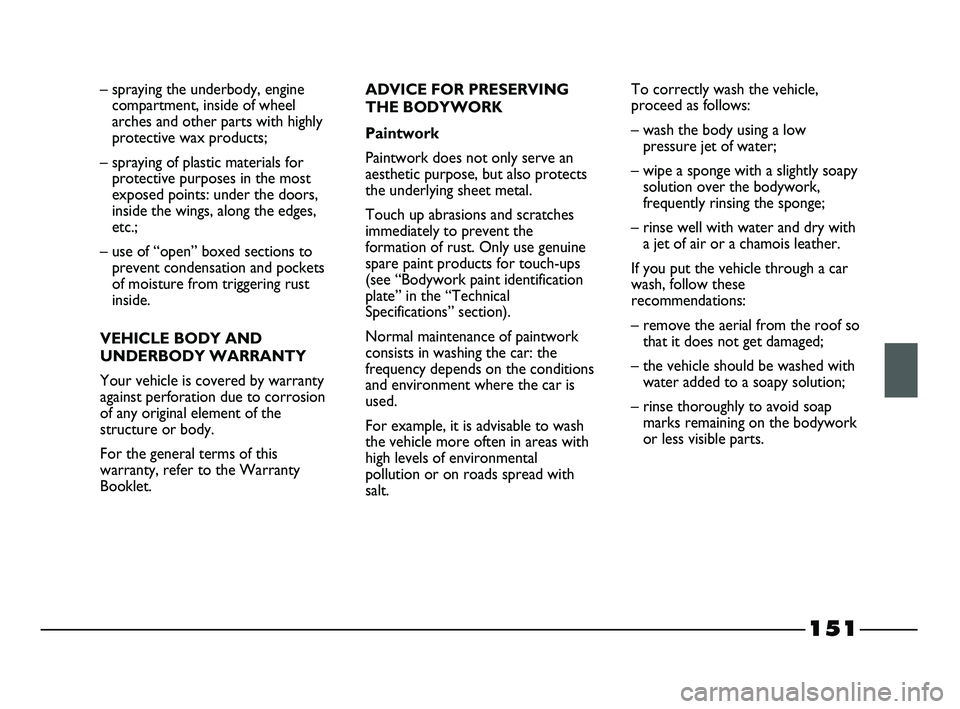
151
– spraying the underbody, engine
compartment, inside of wheel
arches and other parts with highly
protective wax products;
– spraying of plastic materials for
protective purposes in the most
exposed points: under the doors,
inside the wings, along the edges,
etc.;
– use of “open” boxed sections to
prevent condensation and pockets
of moisture from triggering rust
inside.
VEHICLE BODY AND
UNDERBODY WARRANTY
Your vehicle is covered by warranty
against perforation due to corrosion
of any original element of the
structure or body.
For the general terms of this
warranty, refer to the Warranty
Booklet.ADVICE FOR PRESERVING
THE BODYWORK
Paintwork
Paintwork does not only serve an
aesthetic purpose, but also protects
the underlying sheet metal.
Touch up abrasions and scratches
immediately to prevent the
formation of rust. Only use genuine
spare paint products for touch-ups
(see “Bodywork paint identification
plate” in the “Technical
Specifications” section).
Normal maintenance of paintwork
consists in washing the car: the
frequency depends on the conditions
and environment where the car is
used.
For example, it is advisable to wash
the vehicle more often in areas with
high levels of environmental
pollution or on roads spread with
salt.To correctly wash the vehicle,
proceed as follows:
– wash the body using a low
pressure jet of water;
– wipe a sponge with a slightly soapy
solution over the bodywork,
frequently rinsing the sponge;
– rinse well with water and dry with
a jet of air or a chamois leather.
If you put the vehicle through a car
wash, follow these
recommendations:
– remove the aerial from the roof so
that it does not get damaged;
– the vehicle should be washed with
water added to a soapy solution;
– rinse thoroughly to avoid soap
marks remaining on the bodywork
or less visible parts.
133-154 STRADA LUM GB 1ed 9-01-2012 14:53 Pagina 151
Page 157 of 187

TECHNICAL SPECIFICATIONS
IDENTIFICATION DATA
It is advisable to take note of the
identification codes.
The following identification codes
are printed and shown on the plates:
– Vehicle identification number
(VIN) plate.
– Chassis marking.
– Bodywork paint identification
plate.
– Engine marking.VIN PLATE fig. 1
This plate is fitted to the engine
compartment air intake chamber and
bears the following information:
B Type-approval number.
C Vehicle type identification code.
D Chassis number.
E Maximum authorised weight of
vehicle fully laden.
F Maximum authorised weight of
vehicle fully laden plus trailer.
fig. 163
F0X0147m
G Maximum authorised weight on
first axle (front).
H Maximum authorised weight on
second axle (rear).
I Engine type.
L Bodywork version code.
M Number for spare parts.
N Correct smoke coefficient value.
155
155-184 STRADA LUM GB 1ed 20-01-2012 9:34 Pagina 155
Page 161 of 187
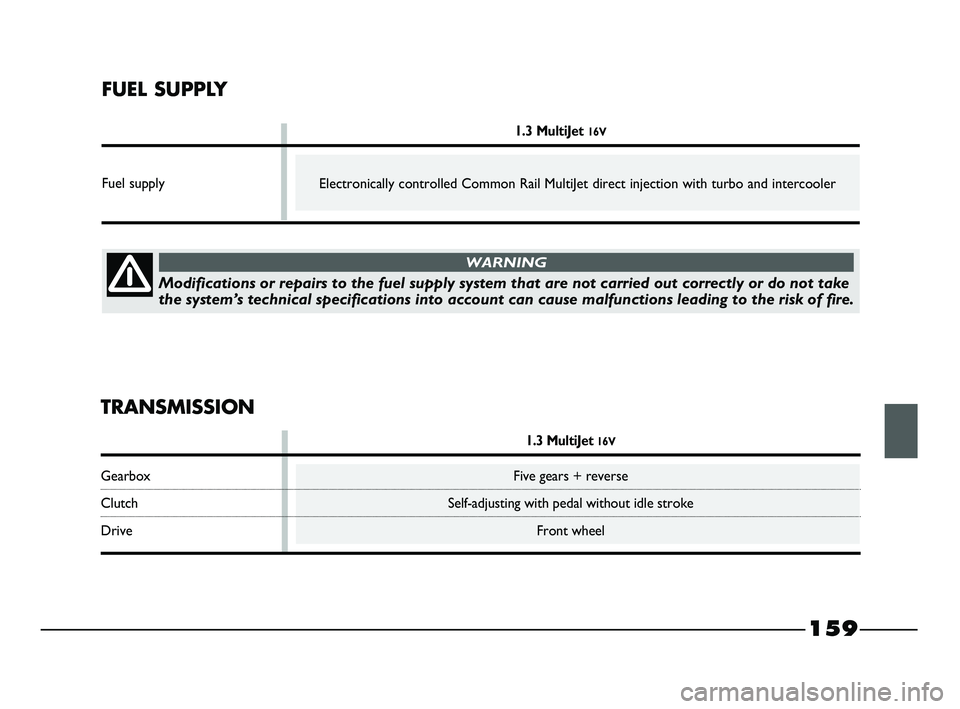
159
FUEL SUPPLY
1.3 MultiJet 16V
Fuel supply
TRANSMISSION
1.3 MultiJet 16V
Gearbox Five gears + reverse
Clutch Self-adjusting with pedal without idle stroke
Drive Front wheel
Electronically controlled Common Rail MultiJet direct injection with turbo and intercooler
Modifications or repairs to the fuel supply system that are not carried out correctly or do not take
the system’s technical specifications into account can cause malfunctions leading to the risk of fire.
WARNING
155-184 STRADA LUM GB 1ed 20-01-2012 9:34 Pagina 159